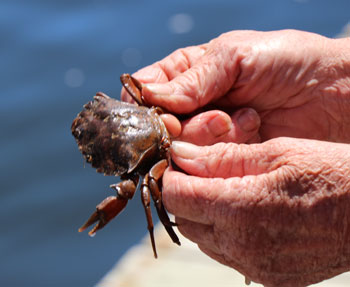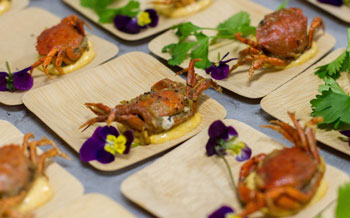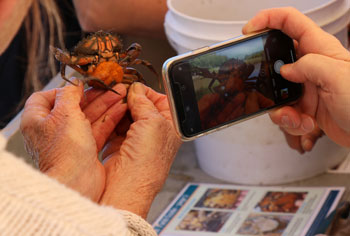Boosting Green Crab Culinary Markets
Continued from Homepage

European green crabs, abundant in Maine, are eyed as a potential new fishery. They are common on Mediterranean menus. Photo courtesy of Manomet.
Battered and deep-fried soft-shell green crabs could be the next culinary sensation – if scientists can get a better handle on when the invasive species molts out of its inedible hard shell.
A lucrative soft-shell green crab fishery has existed in Venice, Italy, for over a century, Manomet Senior Fisheries Scientist Marissa McMahan said. McMahan said Venetian fishermen are paid $25 to $55 per pound for green crabs, depending on season and availability.
Manomet recently received a $267,440 grant, from the National Oceanic and Atmospheric Administration’s Saltonstall-Kennedy Grant Program, to see if the idea can be adapted to create a lucrative market for Maine fishermen.
Over the past couple of years, she said, Manomet has been working with several fishermen, who are volunteering their time to harvest soft-shell green crabs, which they’ve then sold at $3 each to chefs at four restaurants so far. Manomet developed those relationships – at Brunswick’s Brunswick Inn, Enoteca Athena and Henry and Marty’s; and Bath’s Salt Pine Social. The chefs developed the crabs as a battered and deep-fried menu item, served whole.
“The chefs use the soft-shell green crab in the same way they use soft-shell blue crab,” she explained. “It hasn’t completely replaced blue crab on their menus because we don’t have the supply yet.”
The shells are soft enough that they become part of the food, she said.
“They have to shed their old hard shells to grow bigger,” she said. “The new shell formed underneath is paper-thin and almost feels like Jello, it’s so soft.”
The process is called molting. Part of the reason for the study, she said, is to determine when the molt occurs.
It seems like
the market demand
is definitely there.
“We nailed that down to some extent with the males, which generally molt in June and July,” she said. “But female crabs are doing something entirely different. It’s kind of a mystery. The males seem to have a synchronized molt. The females appear to be more random. You’ll find soft shells here and there in warmer months. We suspect there’s something controlling the female molt. Maybe it’s reproductive cycle or the growth cycle.”
So how do you tell females from males? Flip the crab over to view its abdomen. On the male, it’s triangular and pointy. On the female, it’s circular and almost looks like a beehive.
“It’s fairly easy to tell with the naked eye,” she said.
Manomet will tackle the project from several directions, including long-term population monitoring, exploring new pathways to develop the soft-shell fishery, increasing marketing and outreach efforts, and beginning to determine the economic viability of a soft-shell fishery.
Experiments include deploying traps, used to sample catch and perform data measurements. Quadrats are used to perform intertidal monitoring.
Manomet has been able to determine molt indicators that occur on the bottom side of the crab, where a shadow appears in a certain region as the hard shell begins to separate off from the animal.

Fried green crabs have long been a culinary item in Venice, Italy. Photo courtesy of Manomet.
“It’s very subtle, but once you’ve trained yourself to find it, it’s obvious,” she said.
Manomet discovered Venice’s lucrative culinary market for green crab in 2016, when an acquaintance of McMahan’s, Jonathan Taggart, traveled to Venice. A fine arts conservator, he lives in Georgetown, Maine, but was working in Venice and happened to be in a restaurant eating deep-fried soft-shelled green crab.
“He came back and said, ‘Why aren’t we doing this?’” she recalled. “I said, ‘That’s a great question.’”
Taggart brought a Venetian fisherman to Maine. The fisherman stayed for two weeks and helped Manomet work with the crabs and identify the pre-molt. McMahan and her boyfriend, a lobster fisherman, traveled to Venice in 2017 to learn more.
Manomet had been studying green crabs anyway, but from the entirely different tack of trying to figure out how to protect the native soft-shell clam resource from the voracious predators. Now, she said, “Our goal is figure out a way to benefit from them. If they’re here and they’re here to stay, is there a way to take advantage of that? It’s encouraging to see how readily people have responded to this work, and how willing restaurant customers and chefs are to try these products. In general, it’s been really positive and encouraging. It seems like the market demand is definitely there.”
McMahan has eaten the cooked green crabs numerous times. “I love them,” she said. “The chefs we work with say they have a sweet flavor and they’re easy to work with.”
Green crabs are small compared with blue crabs, so the plating differs, she noted.
“If you order them in Venice, you get six or seven crabs on a plate,” as opposed to one large blue crab, she said. “They’re the size of the palm of your hand or smaller. And you get it with fries or polenta or whatever. So it’s like a plate of fried clams or scallops.”
The European green crab was brought to the U.S. in the early 1800s.
Today, they’ve invaded every continent except Antarctica, she said.
“They’re one of the most widely spread and successful species in the world,” she said. “They’re incredibly abundant. They thrive in warmer temperature, so as the Gulf of Maine warms, we’re seeing green crabs are becoming more abundant.”
Places in Massachusetts are inundated with green crabs, she said.
In Ipswich, she said, “Fishermen can catch 1,000 pounds of green crabs in a day, easily.” Maine isn’t at that level yet, she said. “It’s hard to say exactly what the abundance here is, because we don’t sample them the same way we sample lobster, for example. But we can easily set green crab traps and catch hundreds of pounds in a day in a very small area.”

A practiced eye can tell, by looking at the underside, a green crab’s gender and whether it’s ready to molt. Photo courtesy of Manomet.
Ultimately, the study is expected to help figure out if the green crab fishery is viable in terms of the economics and market.
“We need to be able to tell fishermen that, if you go out and produce X amount of green crabs, this is X amount of money you’ll make,” she said. “Because no one will jump into a fishery without knowing the costs and the ultimate benefits. And then we also want to look at some of the biology and ecology.”
In 2013, the Maine Green Crab Summit brought together scientists, fishermen, fishery managers, environmentalists, and other stakeholders to tackle the questions around monitoring and controlling the aggressive invader, and perhaps finding a use for them.
At that time, Bailey Bowden, chairman of the Penobscot Shellfish Conservation Committee, a small town located at the mouth of the Penobscot River, said the invasion there became apparent in 2012. “The number of crabs we have is unbelievable, and they have eaten everything in our bay” and undermined the bay’s banks, causing shoreline erosion, Bowden said at the time.
According to the Department of Marine Resources (DMR), green crabs reached U.S. shores in the mid-1800s after riding cross the Atlantic in the ballast water on ships. They were first spotted in Casco Bay in 1900, and had reached Jonesport by 1951.
Information on the DMR website said the increase in the green crab population has coincided with an increase in ocean temperatures.
“A similar cycle occurred in the early 1950s when the ocean temperatures rose and the green crab population increased, devastating the soft-shell clam resource in Maine,” the DMR says. “This trend reversed during colder winters in the 1960s, effectively reducing the green crab population.”
Efforts have been underway in the private sector to pursue various value-added processes for converting green crabs into useable products, like aquaculture feed, compost, a food additive paste, bait and pet food, the DMR says.
Either way, the DMR say, “Green crabs are causing harm to Maine’s shellfish industry and marine environment. With or without a profit in the green crab resource itself, a sustainability plan is needed for the health of Maine’s current shellfish industries and resources.”
Fishermen can catch
1,000 pounds of
green crabs
in a day.
For the University of Maine Sea Grant blog, Dana Morse in July 2017 wrote that Maine’s problem with the invasive European green crab is not new, nor is the idea of finding a commercial use for them.
“It’s been a tough go for a long time; mostly because it has not been easy to find a market that will pay enough to make it worthwhile for a fisherman to gear up and fish a gang of traps,” Morse wrote. But, he said, the soft-shell culinary variety could be “a beam of light sneaking in through that cloudy scenario.”
Morse wrote that Venice is the center of the Italian soft-shell crab trade, thanks to a closely-related species of green crab. He explained the fishery hinges on being able to identify the molting process.
“As the crab sheds, it swaps out its gill and digestive systems, old for new,” he wrote. “If the crab is taken out of the water within 12 hours of molting, the new shell is still very soft and the new tissues have not developed enough to be objectionable or off-tasting; one eats literally the whole thing.”
Editor’s note: Much of this article originally ran in Mainebiz.
